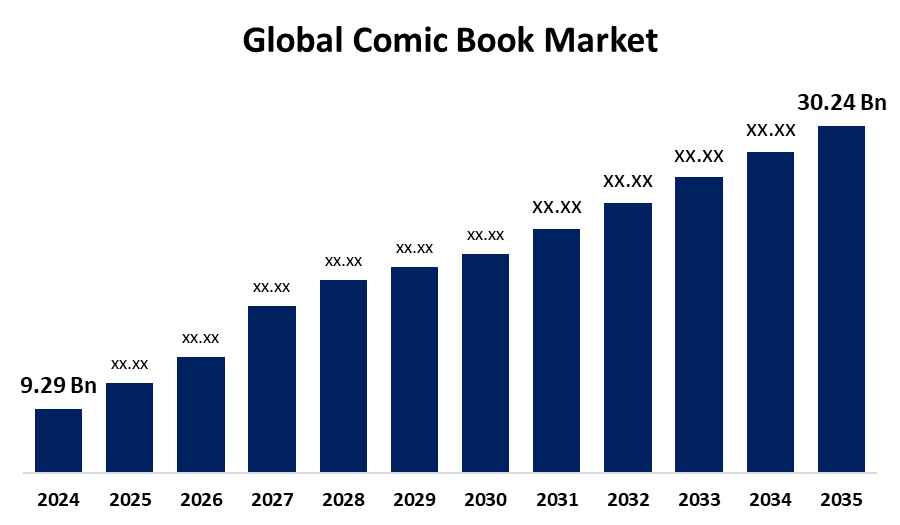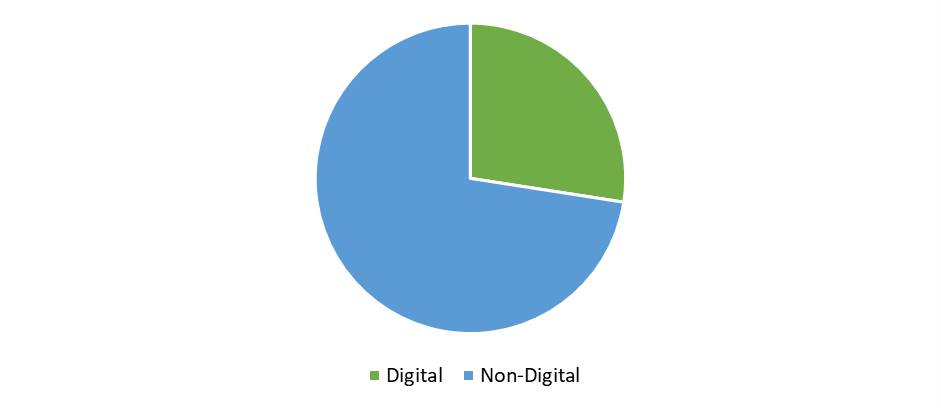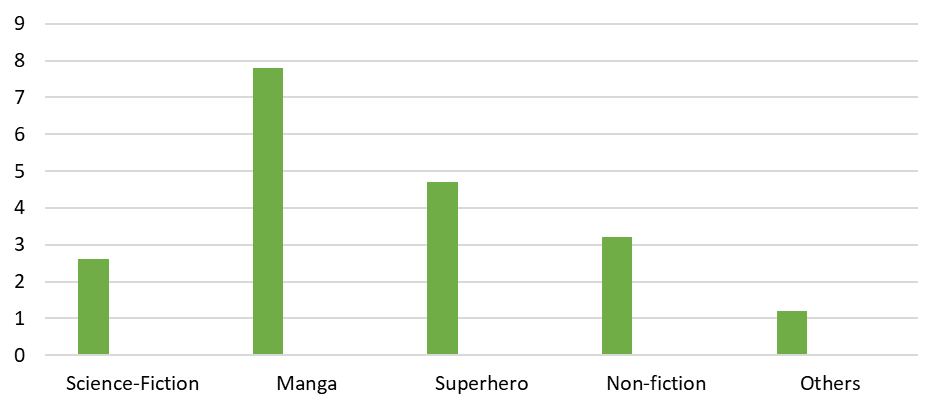Comic Book Market Summary
The Global Comic Book Market Size was valued at USD 9.29 Billion in 2024 and is projected to Reach USD 30.24 Billion by 2035, Growing at a CAGR of 11.33% from 2025 to 2035. The global comic book market is expanding due to increased digital distribution and the growing popularity of comic-based films and television series. Expanding fan communities and diverse material across genres attract a larger audience.
Key Regional and Segment-Wise Insights
- The North American comic book industry is projected to develop at a CAGR of 9.6% from 2025 to 2035.
- The comic book industry in the United States is projected to increase at a 9.3% CAGR from 2025 to 2035.
- In 2024, the comic book industry dominated by the Asia Pacific region accounted for 55.47% of global revenue.
- Based on type, non-digital comic books generated 73.5% revenue in 2024.
- Based on genre, manga comic books made up 40.3% of the revenue in 2024.
Global Market Forecast and Revenue Outlook
- 2024 Market Size: USD 9.29 billion
- 2035 Projected Market Size: USD 30.24 billion
- CAGR (2025-2035): 11.33%
- Asia Pacific: Largest market in 2024

The Comic Book Market exists as a worldwide enterprise that manages everything from comic book production to distribution and retail operations for illustrated stories in sequential art format. The market offers readers physical copies as well as digital versions and features different story genres, including superhero stories, along with manga, fantasy, and science fiction. The market shows consistent growth because of the renewed comic book interest among multiple age groups, together with the rising use of digital platforms. Comic book characters have gained worldwide popularity through media adaptations, which supports the market expansion. More publications with attractive plots and captivating visuals help comics achieve worldwide popularity because of their increased publication numbers. The positive themes in these books enable readers to improve their language skills while they experience magical fantasy realms and learn moral values.
Webtoon and ComiXology revolutionized the industry by delivering both free content alongside paid alternatives to users. The technological innovations enable interactive panels combined with soundtracks and animations to enhance narratives, which produce immersive experiences. Digital comics continue their evolution by bringing diverse voices and expanding their narrative scope beyond traditional superhero themes to establish their permanent role in modern storytelling. The comic book industry works with cinema and television to convert its stories and characters into different media platforms. The cooperative relationship between comic books and other entertainment industries results in higher sales numbers for comic books as well as increased market reach for related merchandise and media products. The market demonstrates an important trend because digital comics now appeal to tech-savvy young consumers. The mutual development between film and television adaptations of comic books creates increased popularity for both media formats. Key players in the comic book industry direct their focus toward digital growth and media adaptation partnerships, along with producing special editions designed for collectors. The approach seeks to control the market while attracting more customers.
Type Insights

In 2024, non-digital comic books accounted for 73.5% of the overall revenue share. The sector is growing as a result of collector demand, nostalgia, and actual experience. This is the growth sector for the traditionalists and collectors who appreciate the physical aspects of comic books, such as the artwork, paper quality, and the act of turning the pages. Collectors and investors are taking notice of physical comic books, especially in the case of limited editions, foreign editions, rare issues, first editions, and variant covers, which can demand high prices. The emergence of professional grading systems (e.g., CGC and CBCS) has increased the investment value of hard-copy comics, which has increased the demand for unique and limited-edition prints. The physical comic book side of the industry is generally considered to be collectible, often having a high resale value, particularly when it comes to rare and antique versions.
The demand for digital comic books is projected to experience a CAGR of 13.6% from 2025 to 2035 due to the broad use of smartphones, tablets, and other digital platforms. Convenience is the principal factor influencing this demand. These comics engage a tech-savvy audience looking for comfort, affordability, and access. Digital comic books are located on various platforms in the form of apps or websites and provide immediate access to an extensive library of comic book publications that is usually cheaper than physical publications. Both usage features, like zooming in and guided view, and new interactive features create an engaging reading experience. This access model is ideal for readers who don't regularly have access to comic book stores or for those who find reading comic books on digital devices easier to manage. Publishers are taking this part of the field seriously by digitizing older comic book publications and creating digital-first comics.
Genre Insights

In 2024, manga comic books made up 40.3% of the revenue. The categorized formats, such as Shonen (young male), shoji (young female), seinen (adult male), and josei (adult female), appeal to the broadest demographic since it is not aimed at a specialist audience. Unlike typical Western comics, manga allows for the genre to vary greatly, such as action, romance, fantasy, slice-of-life, horror, and nonfiction, which appeal to readers of all ages and tastes. Digital manga platforms like Shonen Jump, Manga Plus, and WEBTOON have expanded to enable a more convenient way to access collections of titles, making it easier for overseas users to consume content legally and affordably. The simultaneous digital releases and increased translation efforts regarding manga have also greatly improved the growth of readership around the world.
From 2025 to 2035, the superhero comic book market is forecast to grow at a CAGR of 10.4%. Superhero comics were mainly written for children, but children are not the only readers of superhero comics anymore, as many adults have read too many superhero comics now. The Marvel Cinematic Universe (MCU) and DC Extended Universe (DCEU) franchises have become a part of pop culture and given life to comic book characters like Spider-Man, Batman, and Wonder Woman on a global scale, resulting in more superhero comic book reading from all ages of Americans stepping up. For example, in July 2022, Marvel celebrated the release of their 30,000th comic book with two major giveaways, which allowed readers to get 30 free comic books and the launch of the Infinity Series Avengers Unlimited on the Marvel Unlimited app.
Regional Insights
The North American comic book market is expected to grow at a CAGR of 9.6% from 2025 to 2035, based on technological advancements, changes in consumer choice, and varied content. The emergence of so many comic book artists in North America has led to tremendous growth in product sales. Furthermore, North America has a wide range of genres and a large, long-standing community of committed fans. The embrace of iconic superheroes, as well as strong investments in new comic book series and new digital platforms, continues to drive industry growth. New platforms such as ComiXology, Webtoon, and Tapas have expanded access to comic books, especially with younger, tech-savvy consumers who prefer digital content. This shift allows independent creators to reach audiences worldwide without being constrained by traditional publishing.
U.S. Comic Book Market Trends
The comic book industry in the US is expected to experience growth with a CAGR of 9.3% from 2025 to 2035. This region has a robust culture of comics fandom with a large comic book retailer network as well as conventions like Comic Con. The progress of comic book adaptations in Hollywood has also tremendously helped establish comic book characters and stories. In addition, cross-platform adaptations such as movies and television shows based on comic book characters have a tremendous impact on interest and sales. Moreover, collectible editions and limited run variants have also gained traction with collectors and enthusiasts.
Asia Pacific Comic Book Market Trends
The comic book industry in Asia Pacific dominated the market by representing 55.47% of the total global market revenue in 2024. With countries like Japan, famous for their global manga culture, and South Korea, known for webtoons, they continue to be significant players in driving the industry growth. As the readership base expands to include younger people and adults, the demand for comics increases across different genres and formats. Additionally, the rise of digital platforms in Asia Pacific has allowed for greater access to comics and promoted market growth. A committed fan base, a variety of cultures, and the potential for new content will be critical in maintaining a leading position in the global comic book industry.
Europe Comic Book Market Trends
The comic book market in Europe generated 19.4% of the overall revenue in 2024, primarily due to a shift in consumer buying habits, advances in technology, and the increased access to comics through e-books and audiobooks. Manga is the most popular genre in European countries. The region also has classic comic lines which have worldwide appeal like 'Asterix', 'Tintin and 'The Smurfs.' The European market has notable attributes, which include an extended history of comic art formats, regional comic festivals, and a developing independent comic book illustration market. Moreover, the European marketplace is set to expand due to the increasing demand for both local and international comic books, including the developing digital distribution at a pace, and linked to the European comic book marketplace.
Key Comic Book Companies:
The following are the leading companies in the comic book market. These companies collectively hold the largest market share and dictate industry trends:
- Disney
- PANINI S.P.A.
- DC Comics
- Shogakukan Inc.
- Dark Horse Comics
- Image Comics
- IDW Publishing
- HAKUSENSHA
- Shueisha Inc.
- TOKYOPOP
- Others
Recent Developments
- In March 2025, the Star Trek comic publisher IDW announced that three separate limited series would debut in 2025. The three upcoming series will begin with a red-shirted crew member's story before exploring Strange New Worlds and ending with Voyager's last mission. The first series, STAR TREK: RED SHIRTS, has debut in July and consist of five issues. The story, written by Christopher Cantwell and illustrated by Megan Levens, follows a group of Security personnel from the USS Warren.
- In February 2025, Image Comics has partnered with Sweet Shop, a new digital comics platform launching this summer. The app plans to leverage Image Comics to help create a viable comic-reader alternative, providing over 400 creator-owned publications to readers around the globe on Apple and Android devices. This new app creates an interesting new feature utilizing vertical scrolling. Anyone who reads webcomics would love this feature, as well as right-to-left and left-to-right reading options for applicable titles.
Market Segment
This study forecasts revenue at global, regional, and country levels from 2020 to 2035. Spherical Insights has segmented the comic book market based on the below-mentioned segments:
Global Comic Book Market, By Type
Global Comic Book Market, By Genre
- Science-Fiction
- Manga
- Superhero
- Non-fiction
- Others
Global Comic Book Market, By Regional Analysis
- North America
- Europe
- Germany
- UK
- France
- Italy
- Spain
- Russia
- Rest of Europe
- Asia Pacific
- China
- Japan
- India
- South Korea
- Australia
- Rest of Asia Pacific
- South America
- Brazil
- Argentina
- Rest of South America
- Middle East & Africa
- UAE
- Saudi Arabia
- Qatar
- South Africa
- Rest of the Middle East & Africa






